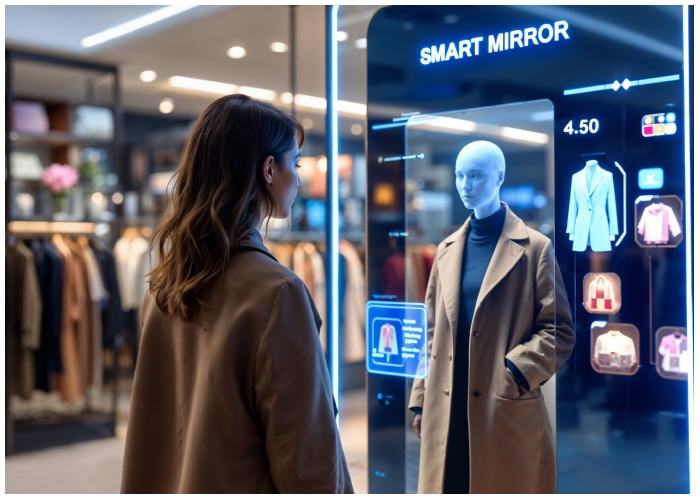It’s easy to miss, but artificial intelligence is already in your closet—or at least helping you decide what to wear. In 2025, the rise of AI stylists is shifting fashion from gut instinct to guided algorithms. Whether through personalized suggestions from shopping apps or auto-generated outfit planning tools, AI is taking over a part of fashion that used to rely on mood, trend awareness, and personal touch. The result isn’t necessarily bad—it’s just different. And while many haven’t realized it yet, the way we shop, dress, and even define “style” is being reshaped by technology in subtle, persistent ways.
The Rise of the Virtual Closet
What started as apps that helped organize your wardrobe has turned into predictive systems that know when you’ll need a raincoat or when your denim phase is about to end. Tools like virtual closet organizers don’t just log your purchases; they learn from your habits. Over time, they suggest new pairings you hadn’t considered or alert you when you haven’t worn something in months. These seemingly small nudges are redefining how people interact with their wardrobes—not by impulse, but by data.
Algorithms Are the New Tastemakers
Instead of following influencers or poring over runway shots, users are increasingly relying on AI-powered style quizzes, curated feeds, and smart suggestions to inspire their next outfits. Algorithms analyze everything from weather and location to calendar events and social trends, delivering outfit ideas that feel personal and “on-trend” without any manual effort. This convenience is addictive, and it’s replacing the traditional inspiration process for many shoppers—particularly younger generations used to personalization at every digital touchpoint.
AI Styling Is Leveling the Playing Field
One unexpected upside of AI stylists is that they’ve made fashion more accessible to people who’ve never felt confident picking clothes. If you didn’t grow up knowing how to mix patterns or layer for different body types, AI offers shortcuts to style fluency.

Many apps offer body-specific recommendations or let users plug in mood or occasion-based goals, offering outfits tailored to someone’s actual life, not just runway fantasy. It’s democratizing style in a way old-school fashion never did.
Style Feels Safer—but Less Personal
As helpful as AI is, it often leads users toward safer bets. Because algorithms are trained on data—likes, engagement, purchase history—they tend to reinforce the most common denominators. That means classic silhouettes, neutral palettes, and popular items get pushed more often, making it harder for true originality to surface. When everyone’s following the same AI suggestions, personal style starts to look suspiciously similar—and the fashion landscape loses a bit of its eccentric magic.
Influencers Are Using AI Too
AI stylists aren’t just for everyday users. Many fashion influencers now use AI-driven tools to plan looks, track inventory, and analyze their audience’s preferences. Some even use AI to help caption their posts or schedule outfits based on seasonal trends. As more of the fashion content we see becomes machine-optimized, it’s getting harder to tell what’s authentically personal and what’s subtly algorithm-approved. The illusion of effortless style is now a lot more calculated than we think.
Brands Are Designing for the Algorithm
Major fashion retailers are also playing into the AI shift, designing collections that photograph well on feeds or work seamlessly with outfit planners. Instead of just targeting seasons or aesthetics, some collections are built to win algorithmic favor—high engagement colors, universally flattering cuts, and versatile basics that get pushed by AI suggestion engines. The result is fashion that’s hyper-optimized but sometimes lacking soul, built more for discoverability than for daring.
Customization Is the New Luxury
Interestingly, AI stylists are also fueling the demand for personalization. The more users get used to tailored suggestions, the less patience they have for one-size-fits-all fashion. This is pushing brands to offer more customizable features, from choosing your fabric and hemline to made-to-order colorways. AI has raised the bar for what shoppers expect in terms of fit, function, and personalization—and in 2025, that’s redefining what luxury even means.
Sustainability by Default
One unexpected benefit of AI-driven style tools is their impact on sustainability. When your virtual closet tells you how often you’ve worn something or suggests outfits with what you already own, you’re less likely to impulse-buy or overconsume. Some apps even flag pieces that overlap too much with items you already have. This tech-led restraint is helping people make smarter, more conscious choices—even if they’re not intentionally aiming to be sustainable.
The Future of “Taste”
With AI playing a growing role in style discovery and decision-making, the very definition of “good taste” is evolving. It’s no longer just about following trends or standing out—it’s about optimizing for your life, your habits, and your goals. In some ways, that’s liberating. But it also raises the question: if we’re all dressing based on the same smart logic, are we really expressing ourselves—or just letting AI do it for us?